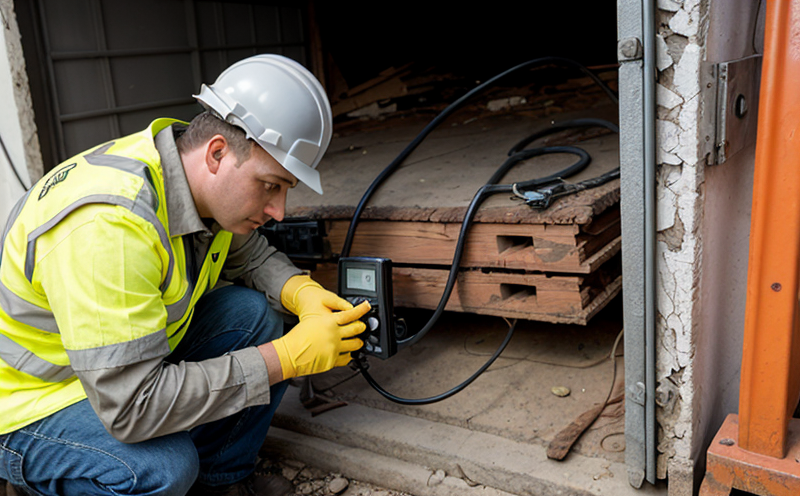Safety device inspection
Ensuring the integrity and reliability of safety devices is crucial in industries that rely heavily on lifting equipment and cranes. Safety devices such as load limiters, emergency stop buttons, and anti-two-block devices are designed to prevent accidents, minimize damage, and protect operators and bystanders. In sectors like construction, manufacturing, and logistics, the failure of a single safety device can lead to catastrophic consequences.
The inspection process involves thorough evaluations using advanced testing equipment and methodologies that adhere to international standards such as ISO 4309:2018 for load limiters or EN 369-1 for anti-two-block devices. The primary goal is to identify any potential weaknesses, failures, or malfunctions before they can lead to incidents.
During a safety device inspection, various checks are performed. For instance, the functionality of emergency stop buttons is tested by simulating a real-time scenario where an operator must respond to a critical situation. Load limiters undergo calibration and performance testing to ensure that they accurately measure load weights and trigger alarms or cut off power when overloaded.
The inspection also includes visual inspections for signs of wear, corrosion, or damage that could affect the device's operation. Additionally, devices are subjected to stress tests where they are pushed to their limits under controlled conditions to assess their durability and reliability. This ensures that safety devices perform as expected in both normal and emergency situations.
For anti-two-block devices, which prevent two blocks from engaging simultaneously with the same load, specialized test rigs simulate lifting operations to verify proper function. Similarly, for load limiters, tests are conducted using calibrated weights to ensure accurate readings under various conditions.
The results of these inspections are meticulously documented and reported. Compliance officers and quality managers rely on these reports to make informed decisions about equipment maintenance schedules and potential replacements. R&D engineers use the findings to improve device designs and reliability. Procurement departments can also leverage this information to select high-quality safety devices that meet international standards.
- ISO 4309:2018 specifies requirements for load limiters used in lifting equipment, ensuring consistent performance across different environments.
- EN 369-1 provides guidelines on the design and construction of anti-two-block devices to prevent accidents caused by improper engagement.
Why It Matters
The importance of safety device inspections cannot be overstated. In industries where heavy lifting is a critical component, the consequences of neglecting safety devices can be severe. Accidents involving cranes and lifting equipment often result in significant property damage, injury to personnel, and potential fatalities.
Regular inspections help prevent such incidents by identifying and rectifying issues before they escalate into major problems. This proactive approach not only enhances workplace safety but also contributes to the overall reputation of companies operating within these sectors. Compliance with international standards is essential for maintaining a safe working environment and ensuring that equipment meets the highest quality benchmarks.
The benefits extend beyond immediate safety concerns; regular inspections contribute to extended equipment lifespan, reduced maintenance costs, and improved productivity. By adhering to strict inspection protocols, companies can minimize downtime and ensure that their operations run smoothly without disruptions due to failures in critical components.
International Acceptance and Recognition
- ISO 4309:2018 – This standard sets out the requirements for load limiters used in lifting equipment, ensuring consistent performance across various environments. Compliance with this standard is essential for manufacturers to ensure their devices meet international quality and safety benchmarks.
- EN 369-1 – This European standard provides guidelines on the design and construction of anti-two-block devices. It ensures that these devices are safe, reliable, and effective in preventing accidents caused by improper engagement. Compliance with this standard is crucial for maintaining a high level of safety in lifting operations.
Environmental and Sustainability Contributions
The inspection of safety devices plays a vital role in promoting sustainability within the industries that rely on lifting equipment. By ensuring that these devices are functioning optimally, inspections help prevent accidents that could lead to environmental damage or waste. For instance, a malfunctioning load limiter might cause an overload accident, leading to potential spills or material loss.
Regular inspections also contribute to the efficient use of resources by preventing unnecessary equipment downtime and ensuring that all components operate at peak efficiency. This not only reduces energy consumption but also minimizes waste in terms of both raw materials and finished products.
In addition, adhering to international standards such as ISO 4309:2018 and EN 369-1 ensures that safety devices are designed with environmental considerations in mind. These standards often incorporate features that reduce energy consumption and improve operational efficiency, contributing positively to the overall sustainability goals of industries.





